Semiconductor manufacturer Magnachip Semiconductor (NYSE:MX) reported results in line with analysts' expectations in Q1 CY2024, with revenue down 13.9% year on year to $49.07 million. On the other hand, next quarter's revenue guidance of $51.5 million was less impressive, coming in 5.7% below analysts' estimates. It made a non-GAAP loss of $0.28 per share, down from its loss of $0.24 per share in the same quarter last year.
Magnachip (MX) Q1 CY2024 Highlights:
- Revenue: $49.07 million vs analyst estimates of $48.73 million (small beat)
- EPS (non-GAAP): -$0.28 vs analyst estimates of -$0.33
- Revenue Guidance for Q2 CY2024 is $51.5 million at the midpoint, below analyst estimates of $54.6 million
- Gross Margin (GAAP): 18.3%, down from 21.2% in the same quarter last year
- Inventory Days Outstanding: 71, down from 76 in the previous quarter
- Free Cash Flow was -$4.64 million compared to -$7.50 million in the previous quarter
- Market Capitalization: $187.9 million
With its technology found in common consumer electronics such as TVs and smartphones, Magnachip Semiconductor (NYSE:MX) is a provider of analog and mixed-signal semiconductors.
Magnachip is headquartered in South Korea and was founded in 2004 after Hynix Semiconductor’s non-memory business was separated from the parent company. Magnachip went public in 2011.
Magnachip’s product portfolio is divided into two segments: Display Solutions and Power Solutions. The company’s Display Solutions technology delivers defined analog voltages and currents that activate pixels on displays. One example is Magnachip’s display drivers, which are chips that serve as interfaces between microprocessors and LCD screens in smartphones. Another example is timing controllers, which are chips that receive and convert image data on screens.
Magnachip’s Power Solutions technology allows for power consumption regulation and efficiency in devices. Examples include various transistors, which enable low standby power consumption in consumer electronics such as laptops so as not to drain the battery when in sleep or standby modes. Driver and regulator technologies in Power Solutions also aid in the heat dissipation needed for many consumer electronics such as tablets to prevent them from getting too hot.
Magnachip’s customers are largely consumer, computing, and industrial electronics OEMs (original equipment manufacturers). The company manufactures most of its Display Solutions products at external foundries, while Power Solutions products are manufactured through a combination of both in-house manufacturing and external foundries.
Competitors offering analog and mixed-signal semiconductors for display and power management include Diodes (NASDAQ:DIOD), Infineon Technologies (XTRA:IFX), and Novatek Microelectronics (TWSE:3034).Sales Growth
Magnachip's revenue has been declining over the last three years, dropping by 22.5% on average per year. This quarter, its revenue declined from $57.01 million in the same quarter last year to $49.07 million. Semiconductors are a cyclical industry, and long-term investors should be prepared for periods of high growth followed by periods of revenue contractions (which can sometimes offer opportune times to buy).
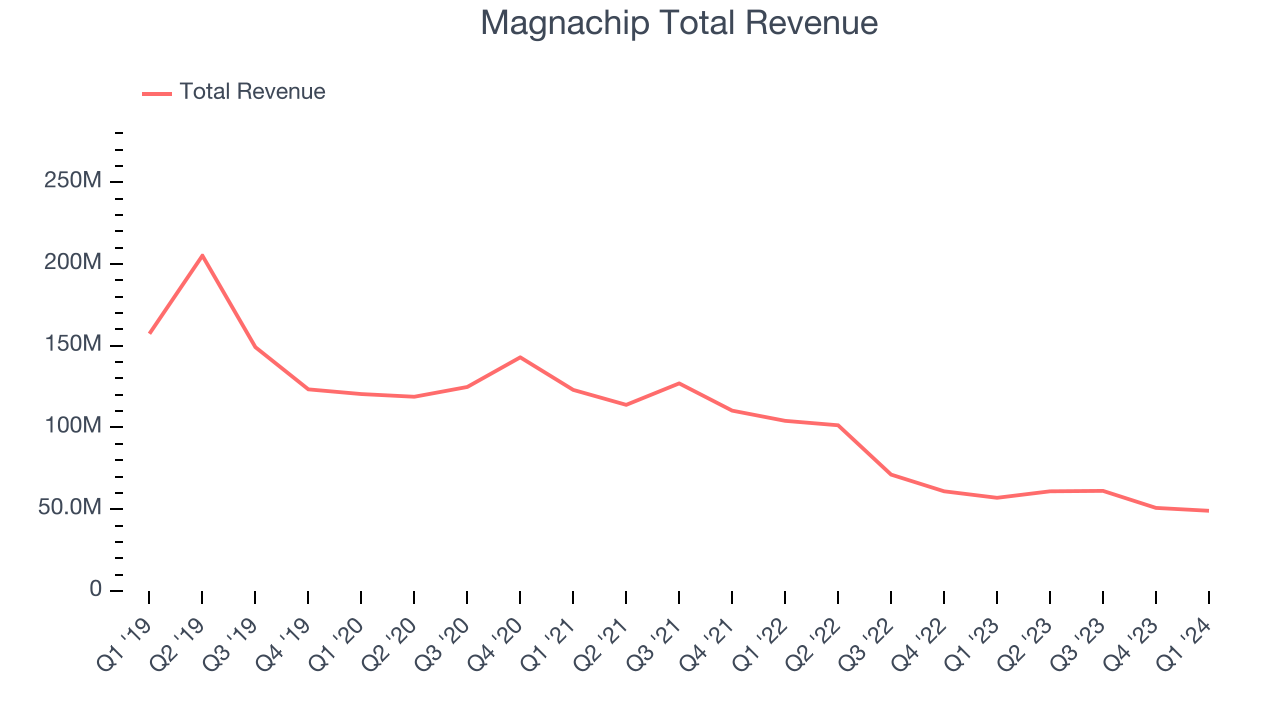
This was a slow quarter for the company as its revenue dropped 13.9% year on year, in line with analysts' estimates. This could mean that the current downcycle is deepening.
Magnachip may be headed for an upturn. Although the company is guiding for a year-on-year revenue decline of 15.5% next quarter, analysts are expecting revenue to grow 14% over the next 12 months.
Product Demand & Outstanding Inventory
Days Inventory Outstanding (DIO) is an important metric for chipmakers, as it reflects a business' capital intensity and the cyclical nature of semiconductor supply and demand. In a tight supply environment, inventories tend to be stable, allowing chipmakers to exert pricing power. Steadily increasing DIO can be a warning sign that demand is weak, and if inventories continue to rise, the company may have to downsize production.
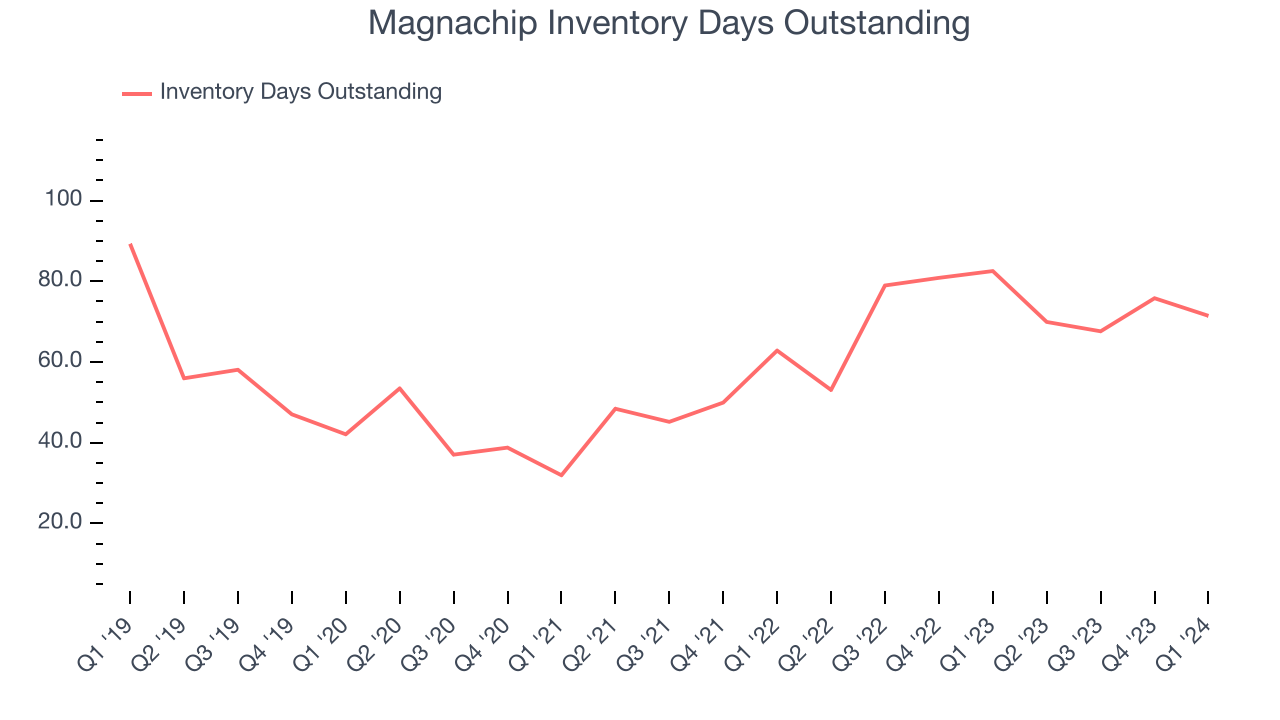
This quarter, Magnachip's DIO came in at 71, which is 14 days above its five-year average. These numbers suggest that despite the recent decrease, the company's inventory levels are higher than what we've seen in the past.
Pricing Power
In the semiconductor industry, a company's gross profit margin is a critical metric to track because it sheds light on its pricing power, complexity of products, and ability to procure raw materials, equipment, and labor. Magnachip's gross profit margin, which shows how much money the company gets to keep after paying key materials, input, and manufacturing costs, came in at 18.3% in Q1, down 2.9 percentage points year on year.
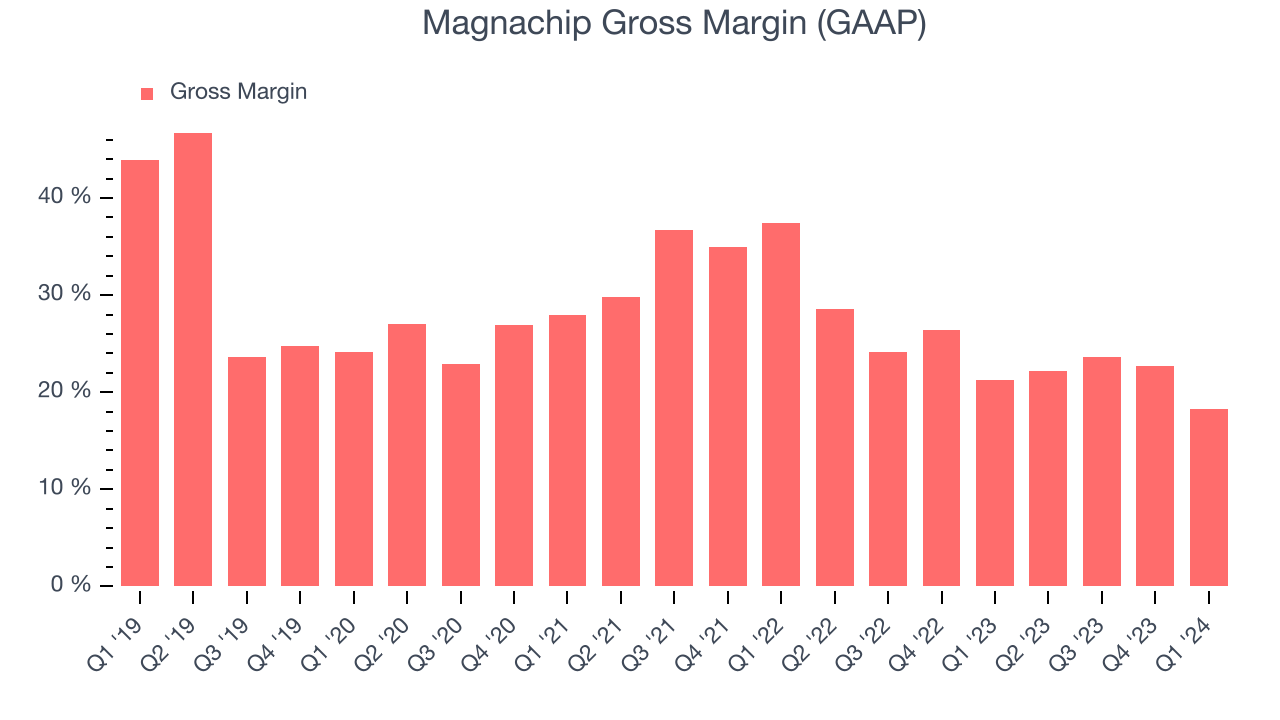
Magnachip's gross margins have been trending down over the last 12 months, averaging 21.8%. This weakness isn't great as Magnachip's margins are already far below other semiconductor companies and suggest shrinking pricing power and loose cost controls.
Profitability
Magnachip reported an operating margin of negative 25.6% in Q1, down 4.1 percentage points year on year. Operating margins are one of the best measures of profitability because they tell us how much money a company takes home after manufacturing its products, marketing and selling them, and, importantly, keeping them relevant through research and development.
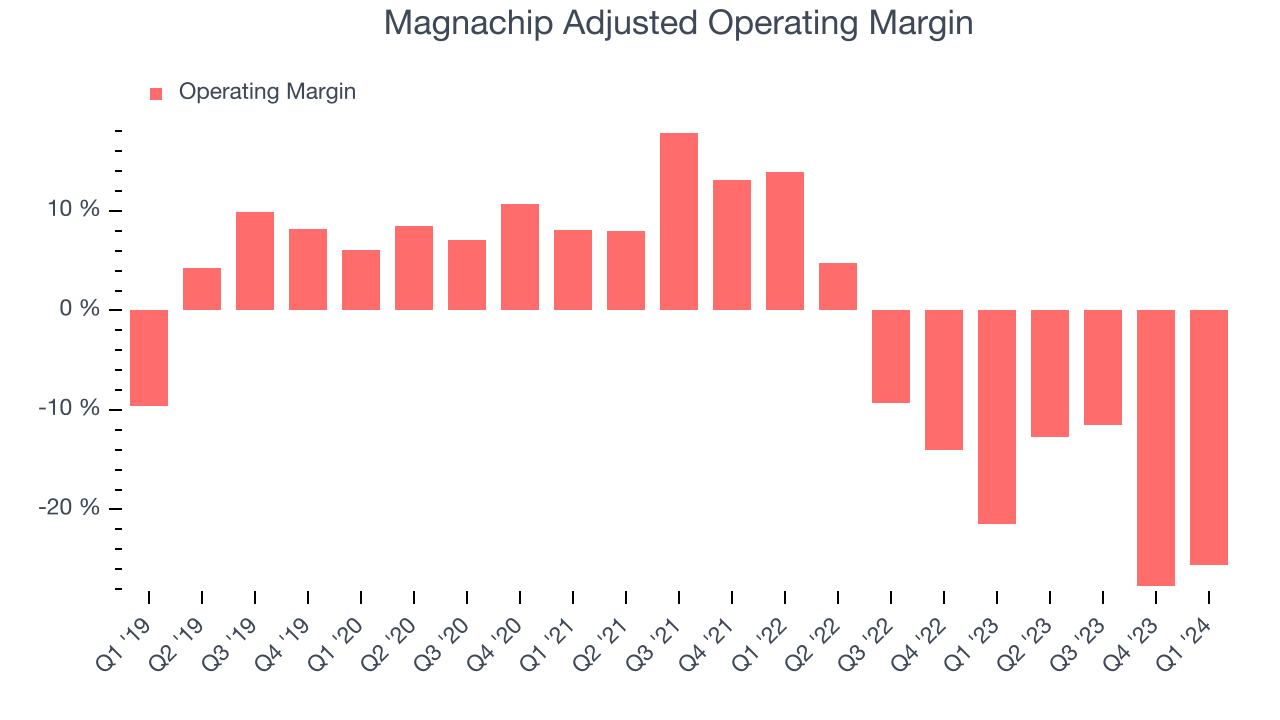
Magnachip's operating margins have been trending down over the last year, averaging negative 18.7%. This is a bad sign for Magnachip, whose margins are already among the lowest for semiconductors. The company will have to improve its relatively inefficient operating model.
Earnings, Cash & Competitive Moat
Wall Street expects earnings per share to decline 281% over the next 12 months, although estimates will likely change after earnings.
Although earnings are important, we believe cash is king because you can't use accounting profits to pay the bills. Magnachip's free cash flow came in at negative $4.64 million in Q1, down 160% year on year.
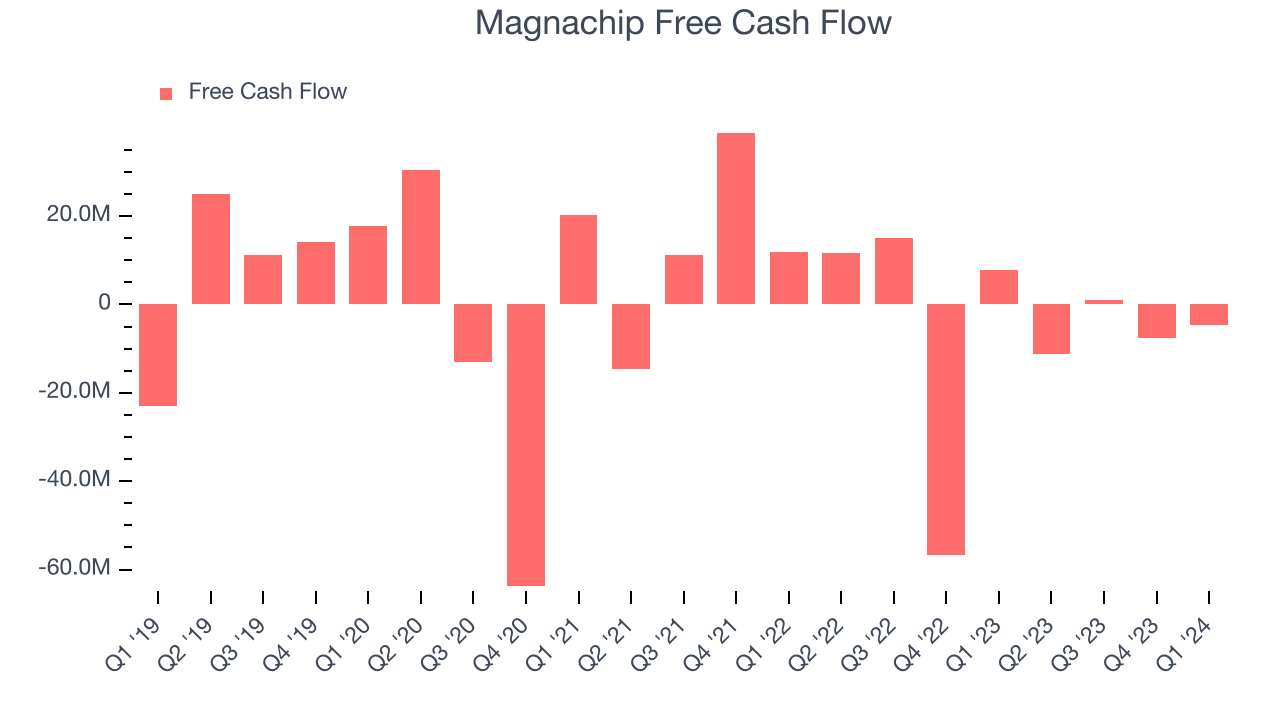
As you can see above, Magnachip failed to produce positive free cash flow over the last 12 months and shareholders will likely want to see an improvement in the coming quarters.
Return on Invested Capital (ROIC)
EPS and free cash flow tell us whether a company was profitable while growing revenue. But was it capital-efficient? A company’s ROIC explains this by showing how much operating profit a company makes compared to how much money the business raised (debt and equity).
Magnachip's five-year average ROIC was negative 1.5%, meaning management lost money while trying to expand the business. Its returns were among the worst in the semiconductor sector.
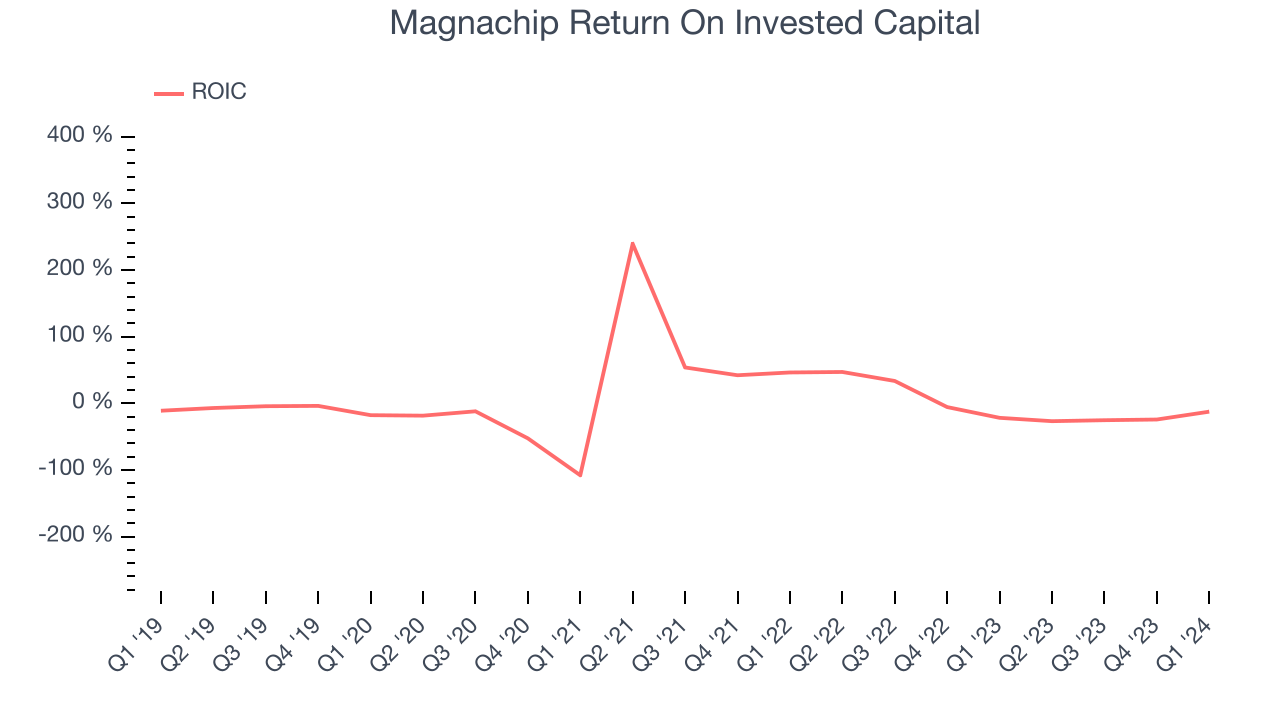
The trend in its ROIC, however, is often what surprises the market and drives the stock price. Unfortunately, Magnachip's ROIC significantly decreased over the last few years. Paired with its already low returns, these declines suggest the company's profitable business opportunities are few and far between.
Key Takeaways from Magnachip's Q1 Results
We were impressed by how significantly Magnachip blew past analysts' EPS expectations this quarter. We were also glad its inventory levels shrunk. On the other hand, its revenue guidance for next quarter missed analysts' expectations and its gross margin shrunk. Overall, this was a mixed quarter for Magnachip. The stock is up 4.5% after reporting and currently trades at $5.15 per share.
Is Now The Time?
When considering an investment in Magnachip, investors should take into account its valuation and business qualities as well as what's happened in the latest quarter.
We cheer for everyone who's making the lives of others easier through technology, but in the case of Magnachip, we'll be cheering from the sidelines. Its revenue has declined over the last three years, and analysts expect growth to deteriorate from here. On top of that, its relatively low ROIC suggests it has struggled to grow profits historically, and its operating margins reveal subpar cost controls compared to other semiconductor businesses.
While we've no doubt one can find things to like about Magnachip, we think there are better opportunities elsewhere in the market. We don't see many reasons to get involved at the moment.
Wall Street analysts covering the company had a one-year price target of $10 per share right before these results (compared to the current share price of $5.15).
To get the best start with StockStory check out our most recent Stock picks, and then sign up to our earnings alerts by adding companies to your watchlist here. We typically have the quarterly earnings results analyzed within seconds of the data being released, and especially for the companies reporting pre-market, this often gives investors the chance to react to the results before the market has fully absorbed the information.